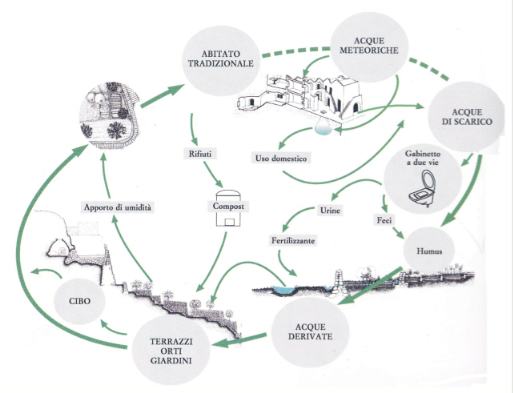GENERAL DEFINITION OF THE TECHNIQUE AUTOPOIETIC COMMUNITIES: Difference between revisions
m (Text replacement - ""/libs/" to ""http://oldtkwb.dev.esacor.com/libs/") |
m (Text replacement - "http://tkwb.org" to "https://tkwb.org") |
||
| (One intermediate revision by the same user not shown) | |||
| Line 19: | Line 19: | ||
<tr> | <tr> | ||
<td> | <td> | ||
<img src=" | <img src="https://tkwb.org/imgcategory/G14.jpg" style="padding: 10px; height: 120px;" /> | ||
</td> | </td> | ||
<td> | <td> | ||
| Line 46: | Line 46: | ||
<p style="text-align: justify;">It has been demonstrated that at a natural level organisms have a higher possibility of surviving using processes of symbiosis and alliances rather than confrontation and hostility. Even for human communities, union and the good use of resources are, historically, a guarantee of success in the long term. These situations of careful relationships between society and nature are found particularly in areas with the most difficult environmental conditions, where the effort necessary to the creation of viability creates and hands down the rules of humility and respect for the environment. However, from the settlement of oases, typical of the desert and autopoietic systems for excellence, you can infer an enlarged model of close man-nature collaboration capable of creating in every condition life cycles, autopoietic ecosystems, therefore capable of self-reproduction, self-perpetuation, and continual self-regeneration. The paradigm of sustainability can therefore be applied to contexts where resources appear to be very abundant that often leads to a progressive increase in their consumption in a process of degenerative trends. Even in a very arid environment free of vegetation like the desert, innumerous specific ecosystems can be found which go against the general pattern, they break up the negative circuit of aridity, the vicious process of impoverishment of the soils, and trigger phenomena of amplification of the available resources. When, maintaining these characteristics, the communities reach superior levels of dimension, of social specialization, of constructive achievement; a sustainable urban ecosystem is determined. This represents the model of oases extended on a vast range of settlement reality based on homeostasis and on the self-maintenance that they make a leap in scale through the exploitation of a trading position or wealth provided by a specific resource. The urban ecosystem is in conclusion the synthesis of local knowledge accumulated in history and in culture. </p> | <p style="text-align: justify;">It has been demonstrated that at a natural level organisms have a higher possibility of surviving using processes of symbiosis and alliances rather than confrontation and hostility. Even for human communities, union and the good use of resources are, historically, a guarantee of success in the long term. These situations of careful relationships between society and nature are found particularly in areas with the most difficult environmental conditions, where the effort necessary to the creation of viability creates and hands down the rules of humility and respect for the environment. However, from the settlement of oases, typical of the desert and autopoietic systems for excellence, you can infer an enlarged model of close man-nature collaboration capable of creating in every condition life cycles, autopoietic ecosystems, therefore capable of self-reproduction, self-perpetuation, and continual self-regeneration. The paradigm of sustainability can therefore be applied to contexts where resources appear to be very abundant that often leads to a progressive increase in their consumption in a process of degenerative trends. Even in a very arid environment free of vegetation like the desert, innumerous specific ecosystems can be found which go against the general pattern, they break up the negative circuit of aridity, the vicious process of impoverishment of the soils, and trigger phenomena of amplification of the available resources. When, maintaining these characteristics, the communities reach superior levels of dimension, of social specialization, of constructive achievement; a sustainable urban ecosystem is determined. This represents the model of oases extended on a vast range of settlement reality based on homeostasis and on the self-maintenance that they make a leap in scale through the exploitation of a trading position or wealth provided by a specific resource. The urban ecosystem is in conclusion the synthesis of local knowledge accumulated in history and in culture. </p> | ||
<p><img alt="" src=" | <p><img alt="" src="https://tkwb.org/libs/kcfinder/upload/images/g14imagescheda1.png" style="width: 513px; height: 393px;" /></p> | ||
<h2 style="margin-top: 50px;">Advantages and sustainability</h2> | <h2 style="margin-top: 50px;">Advantages and sustainability</h2> | ||
| Line 69: | Line 69: | ||
</tr> | </tr> | ||
<tr style="height: 120px;"> | <tr style="height: 120px;"> | ||
<td style="background-color: #f9f9f9;" align="center"><img src=" | <td style="background-color: #f9f9f9;" align="center"><img src="https://tkwb.org/imgcategory/G14.jpg" style="padding: 10px; height: 120px;" /></td> | ||
</tr> | </tr> | ||
<tr style="height: 40px;"> | <tr style="height: 40px;"> | ||
| Line 106: | Line 106: | ||
</tr> | </tr> | ||
<tr> | <tr> | ||
<td> <div style="width: 110px; height: 182px; font-size: 11px; text-align: center; float:left; line-height: 1; cursor: pointer;" ><div style="border: 1px solid rgb(0, 0, 0); text-align: left; margin-left: 5px; margin-top: 2px; width: 35px; padding-left: 1px;">F6</div><a href="/index.php/GENERAL_DEFINITION_OF_THE_TECHNIQUE_ARCHITECTURE_FOR_MANAGING_ENERGY_AND_RESOURCES"> <img src=" | <td> <div style="width: 110px; height: 182px; font-size: 11px; text-align: center; float:left; line-height: 1; cursor: pointer;" ><div style="border: 1px solid rgb(0, 0, 0); text-align: left; margin-left: 5px; margin-top: 2px; width: 35px; padding-left: 1px;">F6</div><a href="/index.php/GENERAL_DEFINITION_OF_THE_TECHNIQUE_ARCHITECTURE_FOR_MANAGING_ENERGY_AND_RESOURCES"> <img src="https://tkwb.org/imgcategory/F6.jpg" width="100" height="100" />ARCHITECTURE FOR MANAGING ENERGY AND RESOURCES </a></div><div style="width: 110px; height: 182px; font-size: 11px; text-align: center; float:left; line-height: 1; cursor: pointer;" ><div style="border: 1px solid rgb(0, 0, 0); text-align: left; margin-left: 5px; margin-top: 2px; width: 35px; padding-left: 1px;">G9</div><a href="/index.php/GENERAL_DEFINITION_OF_THE_TECHNIQUE_FORMS_OF_SOCIAL_SOLIDARITY"> <img src="https://tkwb.org/imgcategory/G9.jpg" width="100" height="100" />FORMS OF SOCIAL SOLIDARITY </a></div><div style="width: 110px; height: 182px; font-size: 11px; text-align: center; float:left; line-height: 1; cursor: pointer;" ><div style="border: 1px solid rgb(0, 0, 0); text-align: left; margin-left: 5px; margin-top: 2px; width: 35px; padding-left: 1px;">E9a</div><a href="/index.php/GENERAL_DEFINITION_OF_THE_TECHNIQUE_GARDEN_TOWN"> <img src="https://tkwb.org/imgcategory/E9a.jpg" width="100" height="100" />GARDEN TOWN </a></div><div style="width: 110px; height: 182px; font-size: 11px; text-align: center; float:left; line-height: 1; cursor: pointer;" ><div style="border: 1px solid rgb(0, 0, 0); text-align: left; margin-left: 5px; margin-top: 2px; width: 35px; padding-left: 1px;">B8</div><a href="/index.php/GENERAL_DEFINITION_OF_THE_TECHNIQUE_HORTICULTURE_COMBINED_WITH_HIGH_TRUNK_PLANTS"> <img src="https://tkwb.org/imgcategory/B8.jpg" width="100" height="100" />HORTICULTURE COMBINED WITH HIGH-TRUNK PLANTS </a></div><div style="width: 110px; height: 182px; font-size: 11px; text-align: center; float:left; line-height: 1; cursor: pointer;" ><div style="border: 1px solid rgb(0, 0, 0); text-align: left; margin-left: 5px; margin-top: 2px; width: 35px; padding-left: 1px;">C11</div><a href="/index.php/GENERAL_DEFINITION_OF_THE_TECHNIQUE_HUMIDITY_CONDENSATION_TECHNIQUES"> <img src="https://tkwb.org/imgcategory/C11.jpg" width="100" height="100" />HUMIDITY CONDENSATION TECHNIQUES </a></div><div style="width: 110px; height: 182px; font-size: 11px; text-align: center; float:left; line-height: 1; cursor: pointer;" ><div style="border: 1px solid rgb(0, 0, 0); text-align: left; margin-left: 5px; margin-top: 2px; width: 35px; padding-left: 1px;">A7</div><a href="/index.php/GENERAL_DEFINITION_OF_THE_TECHNIQUE_INTEGRATED_USE_OF_MARGINAL_AREAS"> <img src="https://tkwb.org/imgcategory/A7.jpg" width="100" height="100" />INTEGRATED USE OF MARGINAL AREAS </a></div><div style="width: 110px; height: 182px; font-size: 11px; text-align: center; float:left; line-height: 1; cursor: pointer;" ><div style="border: 1px solid rgb(0, 0, 0); text-align: left; margin-left: 5px; margin-top: 2px; width: 35px; padding-left: 1px;">C6</div><a href="/index.php/GENERAL_DEFINITION_OF_THE_TECHNIQUE_INTEGRATED_USE_OF_WATER_CATCHMENT_HARVESTING_AND_DISTRIBUTION"> <img src="https://tkwb.org/imgcategory/C6.jpg" width="100" height="100" />INTEGRATED USE OF WATER CATCHMENT, HARVESTING AND DISTRIBUTION </a></div><div style="width: 110px; height: 182px; font-size: 11px; text-align: center; float:left; line-height: 1; cursor: pointer;" ><div style="border: 1px solid rgb(0, 0, 0); text-align: left; margin-left: 5px; margin-top: 2px; width: 35px; padding-left: 1px;">G8</div><a href="/index.php/GENERAL_DEFINITION_OF_THE_TECHNIQUE_KNOWLEDGE_PASSED_ON_DOWN_THE_GENERATIONS"> <img src="https://tkwb.org/imgcategory/G8.jpg" width="100" height="100" />KNOWLEDGE PASSED ON DOWN THE GENERATIONS </a></div><div style="width: 110px; height: 182px; font-size: 11px; text-align: center; float:left; line-height: 1; cursor: pointer;" ><div style="border: 1px solid rgb(0, 0, 0); text-align: left; margin-left: 5px; margin-top: 2px; width: 35px; padding-left: 1px;">D10</div><a href="/index.php/GENERAL_DEFINITION_OF_THE_TECHNIQUE_SYSTEM_OF_SOIL_PROTECTION_WATER_HARVESTING_AND_PROTECTION_AGAINST_THE_WIND"> <img src="https://tkwb.org/imgcategory/D10.jpg" width="100" height="100" />SYSTEM OF SOIL PROTECTION, WATER HARVESTING AND PROTECTION AGAINST THE WIND </a></div><div style="width: 110px; height: 182px; font-size: 11px; text-align: center; float:left; line-height: 1; cursor: pointer;" ><div style="border: 1px solid rgb(0, 0, 0); text-align: left; margin-left: 5px; margin-top: 2px; width: 35px; padding-left: 1px;">A1</div><a href="/index.php/GENERAL_DEFINITION_OF_THE_TECHNIQUE_TABOO_GOODS_AND_RULES_FOR_ACCESS_TO_RESOURCES"> <img src="https://tkwb.org/imgcategory/A1.jpg" width="100" height="100" />TABOO-GOODS AND RULES FOR ACCESS TO RESOURCES </a></div><div style="width: 110px; height: 182px; font-size: 11px; text-align: center; float:left; line-height: 1; cursor: pointer;" ><div style="border: 1px solid rgb(0, 0, 0); text-align: left; margin-left: 5px; margin-top: 2px; width: 35px; padding-left: 1px;">E8</div><a href="/index.php/GENERAL_DEFINITION_OF_THE_TECHNIQUE_TRADITIONAL_ARCHITECTURE_FOR_SETTLEMENTS"> <img src="https://tkwb.org/imgcategory/E8.jpg" width="100" height="100" />TRADITIONAL ARCHITECTURE FOR SETTLEMENTS </a></div><div style="width: 110px; height: 182px; font-size: 11px; text-align: center; float:left; line-height: 1; cursor: pointer;" ><div style="border: 1px solid rgb(0, 0, 0); text-align: left; margin-left: 5px; margin-top: 2px; width: 35px; padding-left: 1px;">E9</div><a href="/index.php/GENERAL_DEFINITION_OF_THE_TECHNIQUE_TRADITIONAL_URBAN_LAYOUT"> <img src="https://tkwb.org/imgcategory/E9.jpg" width="100" height="100" />TRADITIONAL URBAN LAYOUT </a></div><div style="width: 110px; height: 182px; font-size: 11px; text-align: center; float:left; line-height: 1; cursor: pointer;" ><div style="border: 1px solid rgb(0, 0, 0); text-align: left; margin-left: 5px; margin-top: 2px; width: 35px; padding-left: 1px;">E6</div><a href="/index.php/GENERAL_DEFINITION_OF_THE_TECHNIQUE_TYPOLOGIES_OF_OASIS_SETTLEMENTS"> <img src="https://tkwb.org/imgcategory/E6.jpg" width="100" height="100" />TYPOLOGIES OF OASIS SETTLEMENTS </a></div><div style="width: 110px; height: 182px; font-size: 11px; text-align: center; float:left; line-height: 1; cursor: pointer;" ><div style="border: 1px solid rgb(0, 0, 0); text-align: left; margin-left: 5px; margin-top: 2px; width: 35px; padding-left: 1px;">F7</div><a href="/index.php/GENERAL_DEFINITION_OF_THE_TECHNIQUE_URBAN_LAYOUT_FOR_RESOURCES_MANAGEMENT"> <img src="https://tkwb.org/imgcategory/F7.jpg" width="100" height="100" />URBAN LAYOUT FOR RESOURCES MANAGEMENT </a></div> </td> | ||
</tr> | </tr> | ||
</table> | </table> | ||
| Line 129: | Line 129: | ||
<table cellpadding="0" cellspacing="0" style="width: 100%; margin-top: 20px; background-color: #DBB497; text-align: center;" height="100"> | <table cellpadding="0" cellspacing="0" style="width: 100%; margin-top: 20px; background-color: #DBB497; text-align: center;" height="100"> | ||
<tr style="height: 100px;"> | <tr style="height: 100px;"> | ||
<td><img src=" | <td><img src="https://tkwb.org/imgcategory/ITKI.jpg" height="60" style="padding-right: 10px; cursor: pointer;" class="tkwb-enable-link" data-obj-link="ITKI" /><img src="/initcp/img/logo.png" height="60" style="padding-right: 10px; cursor: pointer;" class="tkwb-enable-link" data-obj-link="TKWB" /><img src="https://tkwb.org/imgcategory/sitti.jpg" height="60" class="tkwb-enable-link" data-obj-link="SITTI" /></td> | ||
</tr> | </tr> | ||
</table></td> | </table></td> | ||
Latest revision as of 11:12, 15 June 2023
| GENERAL DEFINITION OF THE TECHNIQUE | ||||||||||||||||||||||||||||
|
||||||||||||||||||||||||||||


 ARCHITECTURE FOR MANAGING ENERGY AND RESOURCES
ARCHITECTURE FOR MANAGING ENERGY AND RESOURCES  FORMS OF SOCIAL SOLIDARITY
FORMS OF SOCIAL SOLIDARITY  GARDEN TOWN
GARDEN TOWN  HORTICULTURE COMBINED WITH HIGH-TRUNK PLANTS
HORTICULTURE COMBINED WITH HIGH-TRUNK PLANTS  HUMIDITY CONDENSATION TECHNIQUES
HUMIDITY CONDENSATION TECHNIQUES  INTEGRATED USE OF MARGINAL AREAS
INTEGRATED USE OF MARGINAL AREAS  INTEGRATED USE OF WATER CATCHMENT, HARVESTING AND DISTRIBUTION
INTEGRATED USE OF WATER CATCHMENT, HARVESTING AND DISTRIBUTION  KNOWLEDGE PASSED ON DOWN THE GENERATIONS
KNOWLEDGE PASSED ON DOWN THE GENERATIONS  SYSTEM OF SOIL PROTECTION, WATER HARVESTING AND PROTECTION AGAINST THE WIND
SYSTEM OF SOIL PROTECTION, WATER HARVESTING AND PROTECTION AGAINST THE WIND  TABOO-GOODS AND RULES FOR ACCESS TO RESOURCES
TABOO-GOODS AND RULES FOR ACCESS TO RESOURCES  TRADITIONAL ARCHITECTURE FOR SETTLEMENTS
TRADITIONAL ARCHITECTURE FOR SETTLEMENTS  TRADITIONAL URBAN LAYOUT
TRADITIONAL URBAN LAYOUT  TYPOLOGIES OF OASIS SETTLEMENTS
TYPOLOGIES OF OASIS SETTLEMENTS  URBAN LAYOUT FOR RESOURCES MANAGEMENT
URBAN LAYOUT FOR RESOURCES MANAGEMENT 

